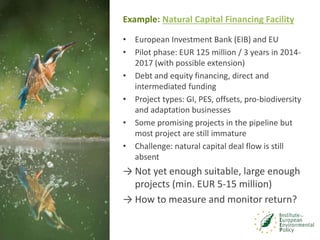Innovative mechanisms for financing biodiversity conservation
- 1. www.ieep.eu @IEEP_eu Innovative mechanisms for financing biodiversity conservation Insights from Europe Daniela Russi, Andrea Illes, Marianne Kettunen & Driss Ezzine-de-Blas 16 December 2016 Cancun, Mexico / CBD COP13 side event With Funded by
- 2. www.ieep.eu @IEEP_eu Taxes, tax incentives, fees and charges (public) Relatively common But only few examples focused directly on biodiversity PES (public, private & hybrid) Mostly public finance Local or regional scale Key focus agricultural & water catchments Investment sector (private) Increasing interest & focus Natural Capital Financing Facility (NCFF) by EIB & EU pioneering the approach Offsetting (public) Controversial and not widely used in practice Pioneered in Germany, France, the UK and Sweden Ecological fiscal transfers (public) New approach Operational only in Portugal Incentives conservation at local level Business sector (private) Increasing interest Focus on sharing best practice and experiences
- 3. • Purpose: Compensate lower-tier governments cover their expenditure in providing public goods and services related to biodiversity conservation • 2007: Idea was pushed by the Ministry for the Environment and accepted by the Ministry of Finance • Protected Areas & Natura 2000 5% (mun. < 70%) - 10% (mun. > = 70%). Share of Ecological Component on Total Municipal Revenues: 18% • 1995-2008: + 4 Reg PA • 2008-2015: + 6 Reg PA Example: Natural Ecological Fiscal Transfers (Portugal)
- 4. Example: Natural Capital Financing Facility • European Investment Bank (EIB) and EU • Pilot phase: EUR 125 million / 3 years in 2014- 2017 (with possible extension) • Debt and equity financing, direct and intermediated funding • Project types: GI, PES, offsets, pro-biodiversity and adaptation businesses • Some promising projects in the pipeline but most project are still immature • Challenge: natural capital deal flow is still absent → Not yet enough suitable, large enough projects (min. EUR 5-15 million) → How to measure and monitor return?
- 5. Example: Mondelēz International • Harmony Charter – initiative on sustainable agriculture and biodiversity protection • Paying premium to wheat producers who commit to improving their production standards (PES) • Min 3% of every Harmony wheat field dedicated to chosen flowers or hedges • Covers more than 2000 farmers in Europe and supplies 75% of west European biscuit volume • A label is put on the products (certification) → Resulted in 22% reduction in pesticide use on average in France → Increased sales and is well perceived by consumers
- 6. Conclusions & reflections from Europe • Increasing experience in PES development and implementation (pollination services, +certification) • Cautious attitude to and several development needs for offsetting • Momentum behind environmental fiscal reform (e.g. EFTs) – but still limited direct buy in by Member States • Public-Private emerging initiatives for investor involvement and impact investment (e.g. EIB / NCFF) • Private impact investment: PES + Green markets • PolicyMix: Need to consider how IFMs can work together with “traditional” public financing instruments
- 7. Reflections Mexico vs. Europe • Decentralized PES (Matching Funds): Attracting new investments and stakeholders (=~NCFF for biodiversity investment) • Continued impact evaluation of the national program of PES: Improved targeting and efficiency of public spending along the last 10 years • New partnerships between NGOs and sustainable business coachers: New investment opportunities (=impact investment projects)
- 8. www.ieep.eu @IEEP_eu Thank you! Daniela Russi drussi@ieep.eu Andrea Illes ailles@ieep.eu Marianne Kettunen mkettunen@ieep.eu Driss Ezzine-de-Blas ezzine@cirad.fr
Editor's Notes
- Taxes: Mention that although not specific taxes exhist they could/will follow the similar pattern like taxes on « unhealthy » goods such as alcohol and tobacco. Food products posing a threat to biodiversity and to the health of ecosystems could be taxed and the collected amount to be invested in good practices (thus combining taxes with intra-sectorial ecological transfers). After mentioning the 6 instruments (4 public, 2 private), explain that we will also deal with three promising IFMs in Europe.
- After purpose: Why such purpose? Decisions about the location of Conservation areas (CA) are frequently taken at higher levels of government, whereas the costs of withholding such areas from other socially and economically beneficial uses are borne by local governments and communities. Rui 2016 slide 28: “After 2007, out of 9 newly created regional/local PAs only 3 where of a category that could not have been designated with the old competencies.”
- GI = Green Infrastructure (corridors).








